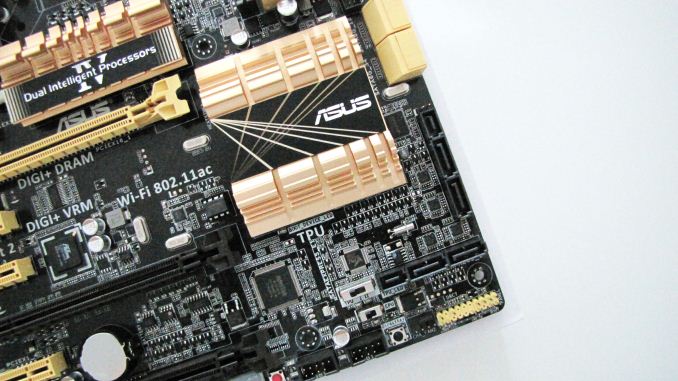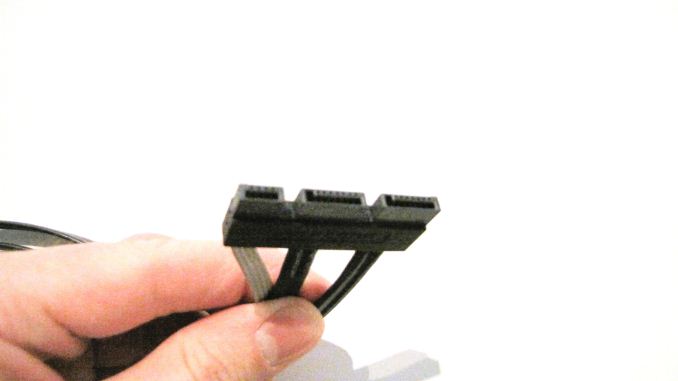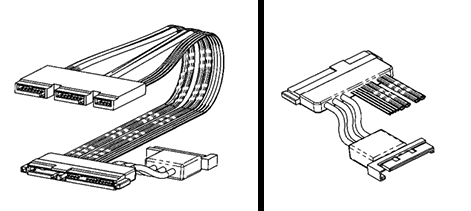Testing SATA Express And Why We Need Faster SSDs
by Kristian Vättö on March 13, 2014 7:00 AM EST- Posted in
- Storage
- SSDs
- Asus
- SATA
- SATA Express
What Is SATA Express?
Officially SATA Express (SATAe from now on) is part of the SATA 3.2 standard. It's not a new command or signaling protocol but merely a specification for a connector that combines both traditional SATA and PCIe signals into one simple connector. As a result SATAe is fully compatible with all existing SATA drives and cables and the only real difference is that the same connector (although not the same SATA cable) can be used with PCIe SSDs.
As SATAe is just a different connector for PCIe, it supports both the PCIe 2.0 and 3.0 standards. I believe most solutions will rely on PCH PCIe lanes for SATAe (like the ASUS board we have), so until Intel upgrades the PCH PCIe to 3.0, SATAe will be limited to ~780MB/s. It's of course possible for motherboard OEMs to route the PCIe for SATAe from the CPU, enabling 3.0 speeds and up to ~1560MB/s of bandwidth, but obviously the PCIe interface of the SSD needs to be 3.0 as well. The SandForce, Marvell, and Samsung designs are all 2.0 but at least OCZ is working on a 3.0 controller that is scheduled for next year.
The board ASUS sent us has two SATAe ports as you can see in the image above. This is a similar port that you should find in a final product once SATAe starts shipping. Notice that the motherboard connector is basically just two SATA ports and a small additional connector—the SATA ports work normally when using a standard SATA cable. It's only when the connector meets the special SATAe cable that PCIe magic starts happening.
ASUS mentioned that the cable is not a final design and may change before retail availability. I suspect we'll see one larger cable instead of three separate ones for esthetic and cable management reasons. As there are no SATAe drives available yet, our cable has the same connector on both ends and the connection to a PCIe drive is provided with the help of a separate SATAe daughterboard. In the final design the other end of the cable will be similar to the current SATA layout (data+power), so it will plug straight into a drive.
That looks like the female part to the SATA connector in your SSD, doesn't it?
Unlike regular PCIe, SATAe does not provide power. This was a surprise for me because I expected SATAe to fully comply with the PCIe spec, which provides up to 25W for x2 and x4 devices. I'm guessing the cable assembly would have become too expensive with the inclusion of power and not all SATA-IO members are happy even with the current SATAe pricing (about $1 in bulk per cable compared to $0.30 for normal SATA cables). As a result, SATAe drives will still source their power straight from the power supply. The SATAe connector is already quite large (about the same size as SATA data + power), so instead of a separate power connector we'll likely see something that looks like this:
In other words, the SATAe cable has a power input, which can be either 15-pin SATA or molex depending on the vendor. The above is just SATA-IO's example/suggestion—they haven't actually made any standard for the power implementation and hence we may see some creative workarounds from OEMs.















131 Comments
View All Comments
MrSpadge - Friday, March 14, 2014 - link
You're right, the increased interface power consumption won't matter much and will be counterbalanced by the quicker execution time. But as far as I understand the bulk of SSD power draw under load, especially for writes, comes from the actual NAND power draw (unless the controller would be really inefficient). If this is true higher performance automatically equates higher SSD power draw under load.willis936 - Thursday, March 13, 2014 - link
I love SATAe and NVMe but whenever SAS is mentioned as a comparison it would be nice to use 12G numbers. I noticed a Microsoft graph showed the 6G but didn't even label it. A doubling of bandwidth is nothing to sneeze at. That said SAS is expensive and is for a very different market.Flunk - Thursday, March 13, 2014 - link
I think they're really making a mistake trying to keep the same connector as SATA. Tacking on a new cable that looks so unwieldy just seems silly. And why not just use M.2 slots? Especially if this is for notebooks (and based on the power usage comparisons it seems like it is, otherwise why would it matter?).I suspect this will go nowhere. Reminds me of ISA 2.0.
Rajinder Gill - Thursday, March 13, 2014 - link
Backwards compatibility with existing SATA devices was the primary reason for keeping the connector as part of the interface. :)Flunk - Thursday, March 13, 2014 - link
I understand that, but there isn't much reason not to have 2 sets of ports with the legacy ones slowly disappearing on a desktop. The ports are not large and there is plenty of space. This way we're stuck with a future of badly-designed ports far past the end of SATA's lifetime.Kristian Vättö - Thursday, March 13, 2014 - link
SATA Express is mainly for desktops -- in mobile M.2 will be the dominant form factor (though SATAe might have some place there too as I mentioned in the article).As for power consumption and battery life, that was about PCIe in general.
phoenix_rizzen - Thursday, March 13, 2014 - link
So why not add M.2 slots to the desktop, in a vertical orientation, and just make M.2->M.2 cables? Then add the M.2 connector to desktop drives?TheinsanegamerN - Monday, March 24, 2014 - link
because, silly, that would mean being progressive and eliminating all backwards compatibility, and we CANT do that! /sin all seriousness, that would be much nicer. manufacturers would probably throw a temper tantrum, but aside from that, it would be a great solution.
grahaman27 - Thursday, March 13, 2014 - link
I would like to see USB 3.1 replace sata6. It sounds unusual, but with the combination of 10Gbps speeds, the new two-way small connector, and integrated power, I think it would really be useful for the expandability and tidiness inside my computer.Veramocor - Thursday, March 13, 2014 - link
Just posted that later on. I have an external usb 3.0 hardrive why can't I have an internal one. Even better would be thunderbolt 2 at 20 Gbps.